英汉翻译的动物文化意象 Animals in translation
- 格式:ppt
- 大小:2.17 MB
- 文档页数:14
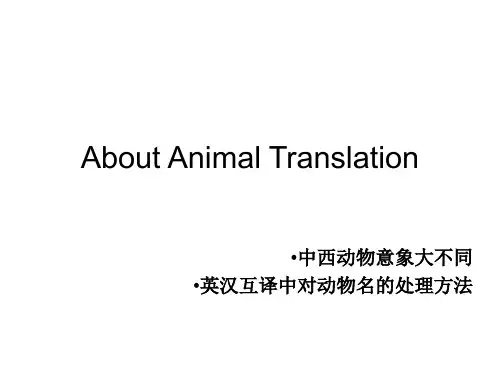
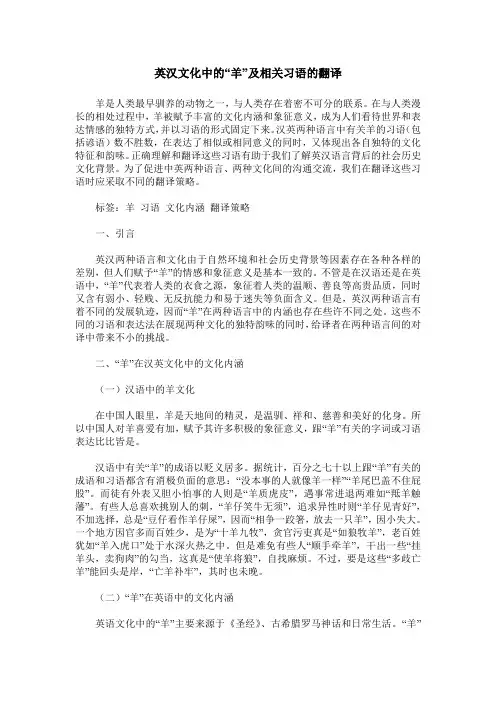
英汉文化中的“羊”及相关习语的翻译羊是人类最早驯养的动物之一,与人类存在着密不可分的联系。
在与人类漫长的相处过程中,羊被赋予丰富的文化内涵和象征意义,成为人们看待世界和表达情感的独特方式,并以习语的形式固定下来。
汉英两种语言中有关羊的习语(包括谚语)数不胜数,在表达了相似或相同意义的同时,又体现出各自独特的文化特征和韵味。
正确理解和翻译这些习语有助于我们了解英汉语言背后的社会历史文化背景。
为了促进中英两种语言、两种文化间的沟通交流,我们在翻译这些习语时应采取不同的翻译策略。
标签:羊习语文化内涵翻译策略一、引言英汉两种语言和文化由于自然环境和社会历史背景等因素存在各种各样的差别,但人们赋予“羊”的情感和象征意义是基本一致的。
不管是在汉语还是在英语中,“羊”代表着人类的衣食之源,象征着人类的温顺、善良等高贵品质,同时又含有弱小、轻贱、无反抗能力和易于迷失等负面含义。
但是,英汉两种语言有着不同的发展轨迹,因而“羊”在两种语言中的内涵也存在些许不同之处。
这些不同的习语和表达法在展现两种文化的独特韵味的同时,给译者在两种语言间的对译中带来不小的挑战。
二、“羊”在汉英文化中的文化内涵(一)汉语中的羊文化在中国人眼里,羊是天地间的精灵,是温驯、祥和、慈善和美好的化身。
所以中国人对羊喜爱有加,赋予其许多积极的象征意义,跟“羊”有关的字词或习语表达比比皆是。
汉语中有关“羊”的成语以贬义居多。
据统计,百分之七十以上跟“羊”有关的成语和习语都含有消极负面的意思:“没本事的人就像羊一样”“羊尾巴盖不住屁股”。
而徒有外表又胆小怕事的人则是“羊质虎皮”,遇事常进退两难如“羝羊触藩”。
有些人总喜欢挑别人的刺,“羊仔笑牛无须”,追求异性时则“羊仔见青好”,不加选择,总是“豆仔看作羊仔屎”,因而“相争一跤箸,放去一只羊”,因小失大。
一个地方因官多而百姓少,是为“十羊九牧”,贪官污吏真是“如狼牧羊”,老百姓犹如“羊入虎口”处于水深火热之中。
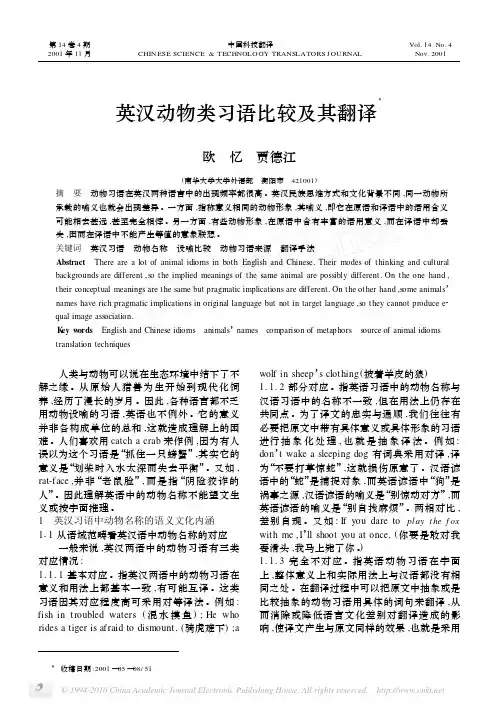
英汉动物类习语比较及其翻译Ξ欧 忆 贾德江(南华大学大学外语部 衡阳市 421001)摘 要 动物习语在英汉两种语言中的出现频率都很高。
英汉民族思维方式和文化背景不同,同一动物所承载的喻义也就会出现差异。
一方面,指称意义相同的动物形象,其喻义,即它在原语和译语中的语用含义可能相去甚远,甚至完全相悖。
另一方面,有些动物形象,在原语中含有丰富的语用意义,而在译语中却丢失,因而在译语中不能产生等值的意象联想。
关键词 英汉习语 动物名称 设喻比较 动物习语来源 翻译手法Abstract There are a lot of animal idioms in both English and Chinese.Their modes of thinking and cultural backgrounds are different,so the implied meanings of the same animal are possibly different.On the one hand, their conceptual meanings are the same but pragmatic implications are different.On the other hand,some animals’names have rich pragmatic implications in original language but not in target language,so they cannot produce e2 qual image association.K ey w ords English and Chinese idioms animals’names comparison of metaphors source of animal idioms translation techniques 人类与动物可以说在生态环境中结下了不解之缘。
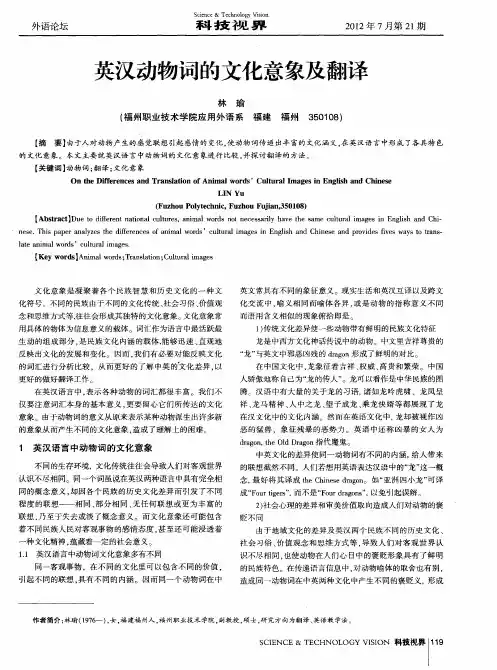
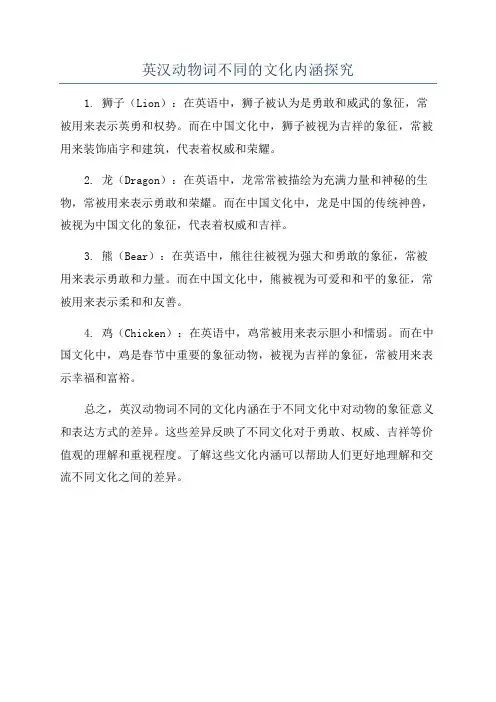
英汉动物词不同的文化内涵探究
1. 狮子(Lion):在英语中,狮子被认为是勇敢和威武的象征,常被用来表示英勇和权势。
而在中国文化中,狮子被视为吉祥的象征,常被用来装饰庙宇和建筑,代表着权威和荣耀。
2. 龙(Dragon):在英语中,龙常常被描绘为充满力量和神秘的生物,常被用来表示勇敢和荣耀。
而在中国文化中,龙是中国的传统神兽,被视为中国文化的象征,代表着权威和吉祥。
3. 熊(Bear):在英语中,熊往往被视为强大和勇敢的象征,常被用来表示勇敢和力量。
而在中国文化中,熊被视为可爱和和平的象征,常被用来表示柔和和友善。
4. 鸡(Chicken):在英语中,鸡常被用来表示胆小和懦弱。
而在中国文化中,鸡是春节中重要的象征动物,被视为吉祥的象征,常被用来表示幸福和富裕。
总之,英汉动物词不同的文化内涵在于不同文化中对动物的象征意义和表达方式的差异。
这些差异反映了不同文化对于勇敢、权威、吉祥等价值观的理解和重视程度。
了解这些文化内涵可以帮助人们更好地理解和交流不同文化之间的差异。
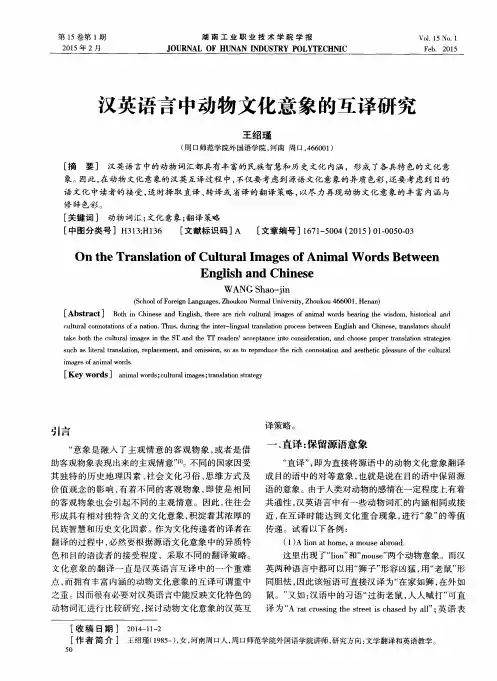
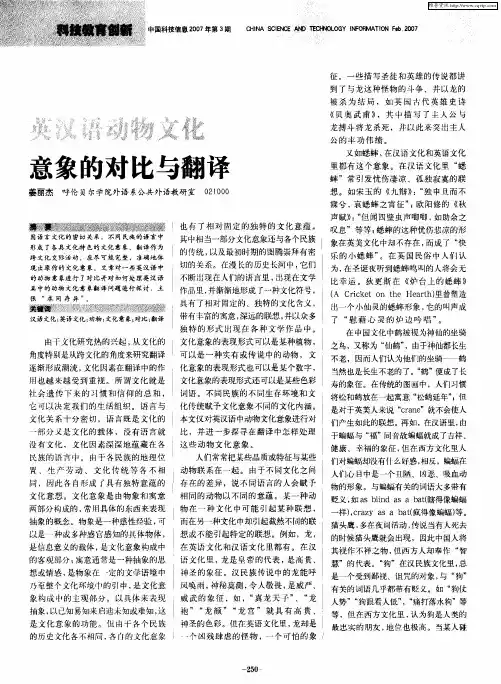
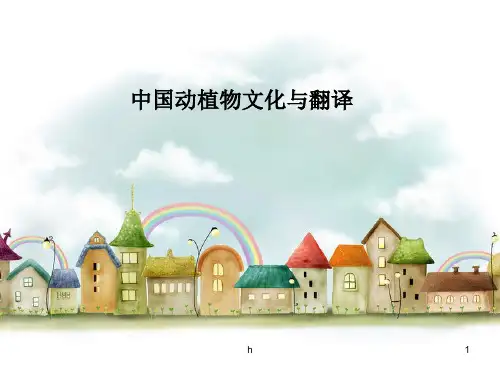
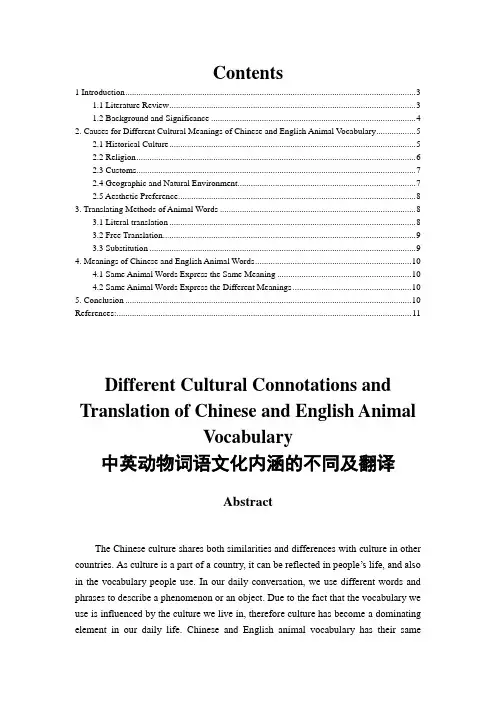
Contents1 Introduction (3)1.1 Literature Review (3)1.2 Background and Significance (4)2. Causes for Different Cultural Meanings of Chinese and English Animal Vocabulary (5)2.1 Historical Culture (5)2.2 Religion (6)2.3 Customs (7)2.4 Geographic and Natural Environment (7)2.5 Aesthetic Preference (8)3. Translating Methods of Animal Words (8)3.1 Literal translation (8)3.2 Free Translation (9)3.3 Substitution (9)4. Meanings of Chinese and English Animal Words (10)4.1 Same Animal Words Express the Same Meaning (10)4.2 Same Animal Words Express the Different Meanings (10)5. Conclusion (10)References: (11)Different Cultural Connotations and Translation of Chinese and English AnimalVocabulary中英动物词语文化内涵的不同及翻译AbstractThe Chinese culture shares both similarities and differences with culture in other countries. As culture is a part of a country, it can be reflected in people’s life, and also in the vocabulary people use. In our daily conversation, we use different words and phrases to describe a phenomenon or an object. Due to the fact that the vocabulary we use is influenced by the culture we live in, therefore culture has become a dominating element in our daily life. Chinese and English animal vocabulary has their sameinterpretation from the perspective of culture, but they also have different cultural meanings. Meanwhile, even for the same object, Chinese and English may have different translations. In some way, it can be said that the cultural differences have led to different translations of animal vocabulary. This paper aims at exploring the different cultural meanings of Chinese and English animal vocabulary from several aspects, namely historical culture, religion, customs and other angles, with the listed three aspects as its main perspectives. At the same time, this paper will also take examples to illustrate the translations of Chinese and English animal vocabulary. Then it will try to discuss the meanings of Chinese and English animal vocabulary from the perspective of culture and its related aspects. Finally, it will come to the conclusion that due to the disparities in historical culture, religion, customs and other various aspects, Chinese and English animal vocabulary may have different cultural meanings, so does their translations.Key words: culture, translation, animal vocabulary, differences, meanings摘要中国文化与其他国家的文化既有相似点,又有不同点。
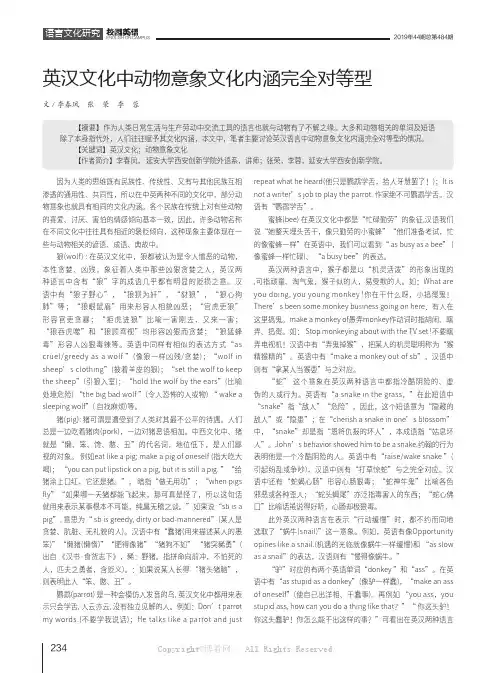
2342019年44期总第484期ENGLISH ON CAMPUS英汉文化中动物意象文化内涵完全对等型文/李春凤 张 荣 李 蓉因为人类的思维既有民族性、传统性、又有与其他民族互相渗透的通用性、共同性,所以在中英两种不同的文化中,部分动物意象也就具有相同的文化内涵。
各个民族在传统上对有些动物的喜爱、讨厌、害怕的情感倾向基本一致,因此,许多动物名称在不同文化中往往具有相近的褒贬倾向,这种现象主要体现在一些与动物相关的谚语、成语、典故中。
狼(wolf) : 在英汉文化中,狼都被认为是令人憎恶的动物,本性贪婪、凶残,象征着人类中那些凶狠贪婪之人,英汉两种语言中含有“狼”字的成语几乎都有明显的贬损之意。
汉语中有“狼子野心”,“狼狈为奸”,“豺狼”,“狼心狗肺”等;“狼眼鼠眉”用来形容人相貌凶恶;“官虎吏狼”形容官吏贪暴;“拒虎进狼”比喻一害刚去,又来一害;“狼吞虎噬”和“狼顾鸢视”均形容凶狠而贪婪;“狼猛蜂毒”形容人凶狠毒辣等。
英语中同样有相似的表达方式“as cruel/greedy as a wolf ”(像狼一样凶残/贪婪);“wolf in sheep’s clothing”(披着羊皮的狼);“set the wolf to keep the sheep”(引狼入室);“hold the wolf by the ears”(比喻处境危险) “the big bad wolf ”(令人恐怖的人或物) “ wake a sleeping wolf”( 自找麻烦)等。
猪(pig): 猪可谓是遭受到了人类对其最不公平的待遇。
人们总是一边吃着猪肉(pork),一边对猪恶语相加。
中西文化中、猪就是“懒、笨、馋、憨、丑”的代名词,地位低下,是人们鄙视的对象。
例如eat like a pig; make a pig of oneself (指大吃大喝); “you can put lipstick on a pig, but it is still a pig. ”“给猪涂上口红,它还是猪。
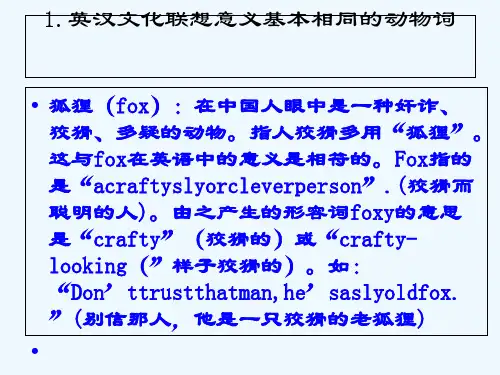
最新英语专业全英原创毕业论文,都是近期写作1 论《荆棘鸟》中的女性意识2 《红字》中丁梅斯代尔的灵魂救赎3 农村初中学生英语学习策略应用情况的调查分析——以xx初中为例4 功能对等视角下汉语广告的英译策略5 跨文化交际中的中西方时间观念6 英语广告中仿拟的关联分析7 文学翻译中的译者主体性8 探究希腊神话对英国戏剧及诗歌的影响9 英语抽象名词和物质名词的数概念分析10 对《老人与海》中圣地亚哥的性格分析11 《月亮与六便士》中查尔斯•思特里克兰德的追寻自我12 论模糊语言在广告英语中的功能与运用13 《幸存者回忆录》中多丽丝•莱辛的生态观14 《野性的呼唤》中巴克形象分析15 从《在路上》解读“垮掉的一代”时代背景与主题16 试析英语广告中双关语的翻译17 论美国情景喜剧《老友记》中的言语幽默18 《洛丽塔》主题与艺术技巧之探析19 国际商务谈判中礼貌策略研究20 论商标翻译的原则及策略21 从中西文化差异的角度浅析商宴之道22 浅论英文原声电影在英语教学中的应用23 商务英语合同的词汇特征24 从关联理论角度分析《绝望主妇》中话语标记语I mean25 The Politeness Principle in English Business Letters26 中西方创世神话文化的比较27 Color Words in Chinese and Western Literature28 《威尼斯商人》中的关键社会元素——莎士比亚心中的乌托邦社会29 The Similarities and the Differences between Gu Hongming and Lin Yutang3031 《基督山伯爵》与亚历山大•大仲马的金钱观32 《那个读伏尔泰的人》英译汉中定语从句的翻译策略33 浅谈电影名称的英汉互译34 中美时间观差异对跨文化交际的影响35 中外汽车文化对比研究36 浅探高中英语听力教学策略37 从语用学角度分析简•奥斯丁的《爱玛》中的会话含义38 功能对等理论指导下的外贸函电翻译39 《洛丽塔》的悲剧分析40 心灵探索之旅——析《瓦尔登湖》的主题41 从文化的角度理解《喜福会》中的母女关系42 浅析《哈克贝利费恩历险记》中的自由43 A Comparative Study on Tea Culture of China and English-speaking Countries44 An Analysis of Textual Functions of the English Passive Voice45 论商务名片英译——以功能对等为指导46 英汉新词理据对比研究47 从生态女性主义视角解析托尼•莫里森的《宠儿》48 文化视角下的英汉委婉语翻译探讨49 山寨文化的反思——发展与创新50 《小镇畸人》的现代主义解读51 目的论视角下的广告翻译52 英国文化中的非语言交际的研究53 An Analysis of the Problems on Chinese Early Childhood Education54 身势语在英语教学中的运用55 On Influence of Cultural Difference in Understanding English and Chinese Advertising56 浅析《还乡》中爱格敦荒原的象征意义57 英语中的女性歧视58 On Michael Moore's Fahrenheit / From the Rhetoric Perspective59 《麦琪的礼物》中环境语的分析60 On Promotion of Rural Middle School Students’ Oral English61 中外汽车文化对比研究62 从关联理论的角度看科技英语翻译63 荒诞与抵抗——《局外人》中莫尔索的荒诞表现之原因分析64 无尽的欲望致使毁灭65 A Comparative Study on Chinese and American Education66 Biblical Ideas on Women and Sex67 解读《纯真年代》中的女性主义68 简奥斯汀对英国小说的贡献——以《傲慢与偏见》为例69 从原型批评理论来看<<哈利波特>>系列小说中的人物原型70 从生态女性主义视角解读《永别了,武器》71 论跨文化因素对广告汉英翻译的影响72 浅谈英语习语的特点及其汉译73 男权制度下的悲剧——论《德伯家的苔丝》74 论《女巫》中的成人形象75 “白+动词”的语义及其英译76 网络英语的构词方式77 从《简•爱》与《藻海无边》看女性话语权的缺失78 《辛德勒名单》主人公性格分析79 从信息层面探析语言翻译中的动态对等原则80 Linguistic Features of English Advertising Language and Its Translation81 英语经济新闻标题翻译在模因传播中的分析82 中英寒暄语的对比与研究83 爱恨共辉煌——浅析《呼啸山庄》中的男主人公84 广告中的熟语模因探析85 分析与比较中美电视新闻的娱乐化,及其未来的发展86 广告翻译中功能对等的研究87 《紫色》主题的表现手法88 A Comparative Study of Chinese and French Higher Education89 从“进步”话语解读《苔丝》中环境因素与人物性格90 An Analysis of David’ s Dual Personality in David Copperfield91 接受美学理论在广告翻译中的运用92 论英汉动物隐喻的异同及其对英语学习的启示93 设计中国际主义风格与民族主义风格的平衡94 从《大象的眼泪》看人与动物的关系95 跨文化交际中身势语的运用对比分析96 谈如何理解海明威《一个干净明亮的地方》97 小说《小公主》主人公萨拉的性格魅力98 《汤姆叔叔的小屋》中的圣经人物原型分析99 《紫色》的生态女性主义解读100 《天边外》的悲剧分析101 从《金色笔记》看多丽丝•莱辛的女性意识102 英汉文化差异对习语翻译的影响103 On the English-Chinese Translation of Entertainment News Reports Viewed from the Stylistic Perspective104 从十字军东征看中世纪宗教冲突105 从顺应论角度看劳伦斯小说中关于心理动机的语码转换106 从英语口语与书面语的不同谈如何正确使用英语口语107 中西方空间观对比研究108 浅谈中国英语与中式英语之差异109 An Analysis of the Cultural Identity in Amy Tan’s The Joy Luck Club110 从功能对等论的角度看电影《暮光之城》的字幕翻译111 消费主义视角下看《麦琪的礼物》中的男女主人公112 《梁山伯与祝英台》和《罗密欧与朱丽叶》之东西方爱情比较113 语域理论观照下的商务合同翻译114 《京华烟云》中姚思安的性格分析115 中英商标翻译中的文化障碍与翻译策略研究116 析《麦田里的守望者》主人公霍尔顿的人生选择117 从谷歌和百度两大企业的管理方式看中美企业文化的差异118 英汉动物习语的文化差异研究119 英语演讲语篇中的parallelism及其汉译策略—以奥巴马就职演说稿为例120 张培基翻译个案研究之背影121 阿法——《多芬的海》中的加勒比人122 用批评性语言分析中美主要矛盾123 A Brief Analysis of Female Consciousness in Cat in the Rain124 Christ Love in Uncle Tom’s Cabin125 英汉关于“愤怒”隐喻的分析126 The Name Translation in A Dream of Red Mansions127 《沙漠之花》的女性主义研究128 从人格结构论视角看《红字》中男女主人公的矛盾心理129 论中美商务谈判中个人主义和集体主义价值观冲突及对策130 《弗洛斯河上的磨坊》中玛姬的性格131 《幸存者回忆录》中多丽丝•莱辛的生态观132 “美国梦”的破灭——《了不起的盖茨比》中的象征133 朋克摇滚的反叛与灵魂乐的激情134 尤金·奥尼尔《进入黑夜的漫长旅程》中人物刻画的反讽手法135 <<罗伯特家的苔丝>>中动植物的作用136 通过对比研究看电影《小红帽》对经典童话小红帽的颠覆137 英汉禁忌语异同之分析与比较138 归化和异化翻译策略的研究139 输出理论在大学英语教学中的应用140 An Archetypal Study of J.D.Salinger’s The Catcher in the R ye141 从两个H男孩的出走看美国历史的变迁142 高中英语教学中的文化教育143 On the Tragic Death of Martin Eden144 《嘉莉妹妹》中的不同价值观的研究145 约翰•斯坦贝克女性观流变初探146 浅析中国时政术语的常用英译方法147 The Environmental Influence on Emily Bront and "Wuthering Heights" 148 中美企业并购中的文化整合分析149 浅谈“白色”在英汉语言中的文化差异及其翻译策略150 英汉习语渊源对比及其常用分析方法151 身势语在国际商务谈判中的应用152 英语动结式V+PP的语义整合研究153 问题类型对TEM阅读成绩影响的实证研究154 模糊语在商务英语谈判中的语用研究155 方位介词“over”的隐喻含义研究156 海明威的死亡哲学——海明威作品解读157 中国特色词汇及其翻译158 论《呼啸山庄》中希斯克利夫的矛盾情感159 The Heartbroken Images in the Fairy Tales of Oscar Wilde160 从功能派翻译理论的角度看商标名称的英译161 源于真爱的结合:简爱的婚姻对当代人的启示162 英汉颜色词文化内涵的异同分析163 文化视角下的商标语翻译策略164 Human Nature and Redemption——Thoughts on Reading The Kite Runner 165 浅谈英文原版电影与高中英语教学166 迷惘一代的英雄:厄内斯特海明威与弗雷德里克亨利167 中法餐桌文化对比168 试论爱伦•坡的作品在当时遭受非议的必然性169 从电影《弱点》看美国的家庭教育170 英文科技产品说明书的语言特点与翻译171 关于英语谚语翻译的一些意见172 The Loss and Gain in Classical Chinese Poetry Translation173 杰克伦敦《野性的呼唤》中人生哲学的主题分析174 透过七夕和情人节看中西文化差异175 《动物农庄》的极权主义的研究176 Current Status of Adverse Drug Reaction Monitoring System in China177 论中美婚礼习俗的差异与融合178 自然与自由之子--新女性戴茜米勒179 游戏在初中英语教学中的作用180 修辞学角度下的女性商品广告的语言分析181 论《哈克贝利费恩历险记》中的对比及效果182 论爱伦•坡小说《莫格街谋杀案》中悬疑的设置183 商务英语书面语语言特色的语用分析184 英语国家姓氏文化研究185 论英汉翻译中的文化因素186 简析文化意识在高中英语学习中的重要性187 An Analysis of Jude’s Pursuit of Love in Jude the Obscure188 英汉语篇衔接手段对比研究——以《荷塘月色》英译本为例189 农村初中学生英语学习策略应用情况的调查分析——以xx初中为例190 《简爱》的特征—一位独立的女性191 “赞同”在英语商务谈判中的应用192 中美学校教育对比——学生个性发展方面193 浅析《老人与海》的主人公——圣地亚哥的人物形象分析194 论《毒日头》中的生命价值观195 从《爱玛》看简•奥斯丁的爱情观196 解析《飘》中斯嘉丽的女性主义思想在其婚姻中的体现197 爵士时代下的狂欢化精神——解析豪华宴会在《了不起的盖茨比》中的写作手法以及作用198 从道德角度分析简•奥斯丁《劝导》中的女主人公安妮•艾略特199 动物词在中英文化中的喻义及其翻译200 英语习语中隐喻的汉译。
animals中文翻译
animals
动物
animal n. 1.动物;兽;牲畜。
2.〔俚语〕家畜,牲口。
3 ... animals of 北极地方动物
in animals 动物中的放射性白内障
the animals 动物合唱团
about animals 英语动物“男女老幼”谈
aggregate animals 群体动物。
agricultural animals 农用牲畜
alpine animals 高山动物
amazing animals 神奇的动物
ancient animals 古动物
animals and colors 动物与颜色
animals and men 动物与人
animals and plants 动植物
animals as teachers 动物亦为师
animals in danqer 濒危动物
animals in the future 将来的动物
animals in translation 倾听动物心语
animals of the prairies 草原上的动物animals on the earth 地球上的动物animals pack 牲畜群
animals pictures 高清晰动物图片集锦animals teeth 兽牙
animals to experimentation 拿动物去做实验animals, cruelty to 虐待动物
aquatic animals 水栖动物; 水生动物。
英汉动物类词语的文化内涵浅析近年来,随着中国与世界联系的日益紧密,中外文化的交流日趋频繁,英汉词语的交流与沟通也更加便利。
在英汉的文化交流中,动物类词语表达了当今英汉文化背后的不同精神内涵,对对两种文化中的人们产生了深远的影响。
本文尝试从文字的方面,浅析英汉动物类词语的基本概念,并探讨其中的文化内涵。
首先,在英语中,有一类叫做“mammal”(哺乳动物)的动物。
它可以代表整个生物界中最普遍的物种,具有眼、耳、大脑和毛皮等典型特征,从它们身上可以看到一种独特的智慧,能够理解和表达人类思想。
因此,在英语中,这类动物类词语常用来比喻智慧、智能、勤劳、性格坚韧等优秀品质。
例如,“wise as an owl”(灵验如猫头鹰)就比喻聪明的人;“smart as a fox”(灵巧如狐狸)则指出了聪明的人;还有“lazy like a sloth”(懒惰如树懒)比喻懒惰的人。
此外,英语中有一类叫做“fish”(鱼)的动物。
由于它们生活在不断变化的水中,需要能够随机应变、适应环境、耐心等待,表现出了一种持久的力量和智慧。
在英语中,鱼类一词用来喻顽强持久,能够抗拒困难、应对挫折的人;例如,strong as a salmon”(坚韧如鲑鱼)比喻勇气无碍的人。
再次,英语中还有“reptile”(爬行动物)一词。
爬行动物需要耐力来面对不断变化的环境,他们拥有独特的感受和反应能力,可以尽可能地利用资源,表现出一种积极进取的心态。
在英语中,爬行动物一词常用来比喻有进取精神的人,例如,“ambitious as a lizard”(野心勃勃如蜥蜴)比喻野心勃勃的人。
最后,中文中也有许多动物类词语,它们描述了人性中不同的特质。
例如,“老虎咆哮”(tiger roars)比喻实力强大,有自信心,也暗指将要出现的灾难或者危险;“狐狸精”(fox Spirit)指出了聪明而狡黠的人;“天鹅精”(swan Spirit)比喻美丽、优雅、温柔的人;“蜘蛛精”(spider Spirit)比喻勤奋、机警、应变能力强的人。
日常生活中,人一般不能与动物相提并论,但语言中却有不少借动物的特性来形容人的特性的词语。
值得注意的是,这种比喻性表达法往往因语言、文化的不同而具有不同的含义。
下面,我们比较一下英汉语言中同一动物名词的不同喻意。
1.cat(猫)俗话说“猫有九命”,这是汉语的说法。
此外,中国人常戏称嘴馋的人为“馋猫”。
cat在西方是人们宠爱之物(pet),但令人奇怪的是,在英语俚语中,cat的含义为a spiteful or unpleasant woman(心地恶毒或令人讨厌的女人)。
照此看来,似乎是中国的猫可亲,西方的猫可恶了。
2.dog(狗)在英语中dog的形象一般不差,常可泛指“个人”。
如谚语:Every dog has his day.(人人皆有得意日。
)又如:a gay dog(快活的人、好玩的人)。
但dog也有形象不佳之时。
如:dog eat dog(注意eat为原形),意指“人们自相残害”;同样,a dog in the manger喻“占着茅坑不拉屎的人”。
在汉语里,尽管狗在某些地方也为宠物,但“狗”的形象总是不雅,因而用来指人时多含贬义。
如“狗咬狗”、“哈巴狗”、“走狗”、“狗仗人势”、“癞皮狗”等等。
3.pig(猪)pig所受待遇可谓最糟,人们总是一边吃猪肉(pork),一边又对猪恶语相加。
汉语里,猪集“懒、笨、馋”于一身,借此喻人具有刻毒之意,其用语不胜枚举。
英国人也给pig以丑恶的形象。
a pig意为a greedy,dirty or bad-mannered person(贪婪、肮脏或无礼貌的人)。
注意,最后一喻意似乎未进入汉语。
4.rat(鼠)汉语中的“胆小如鼠、鼠目寸光、鼠肚鸡肠”及“鼠辈”等词语,皆有“畏琐、卑微”及“心胸狭窄”等含义,可见鼠在汉语中简直一无是处。
作为俚语,英语的rat指人时喻意与汉语稍有出入,但也含贬义:a rat即a person who behaves selfishly(自私的人)或a person who is disloyal(不忠的人)。